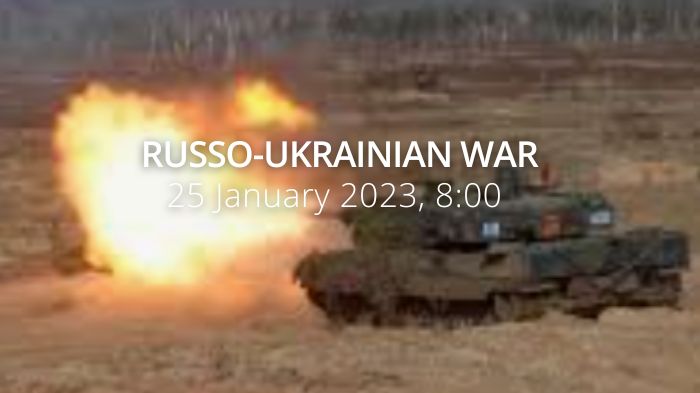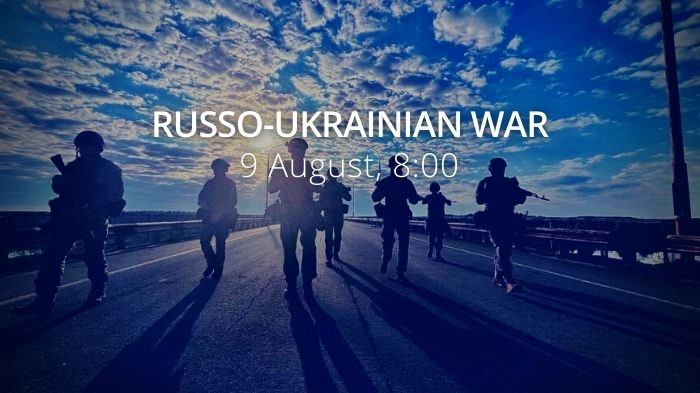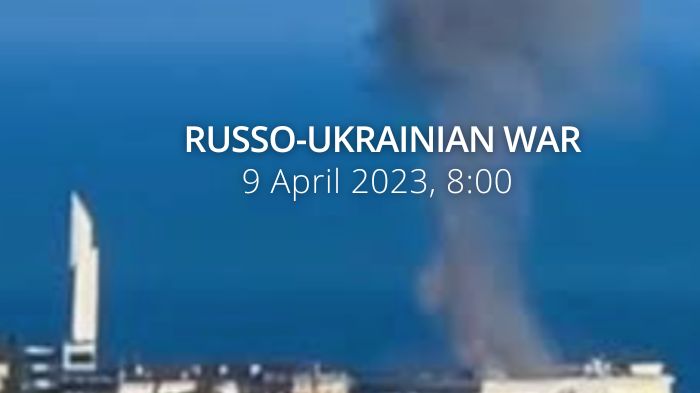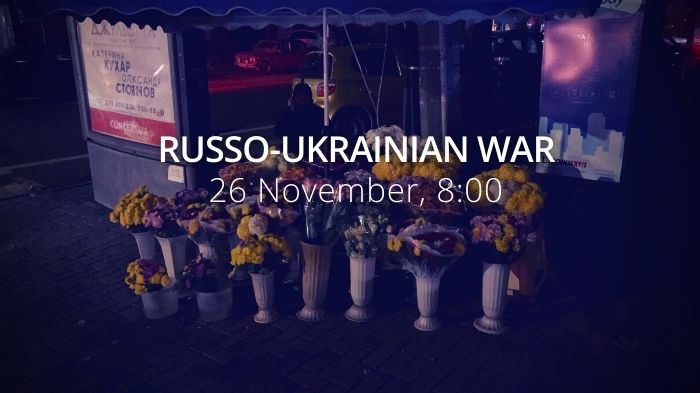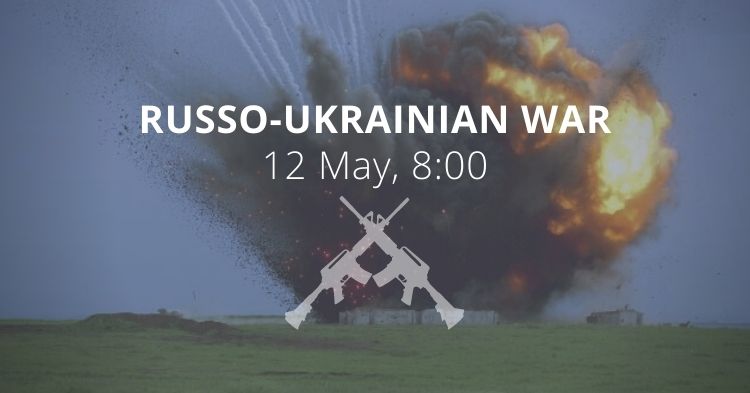Germany approves sending Leopard 2 tanks to Ukraine. 12 countries to supply Ukraine with about 100 Leopard 2 tanks. The Biden administration plans to send M1 Abrams tanks to Ukraine, US officials said.
Western allies urge Ukraine to shift from brutal eastern battle for Bakhmut in Donetsk Obl to southern offensive. For almost 6 months, the Ukrainian defenders have battled the Russians in Bakhmut. Heavy shelling has devastated the town almost entirely.https://t.co/wROV50CqAg
— Euromaidan Press (@EuromaidanPress) January 24, 2023
Daily overview — Summary report, January 25, 2023
The General Staff’s operational update regarding the Russian invasion as of 18.00 pm, January 25, 2023 is in the dropdown menu below:
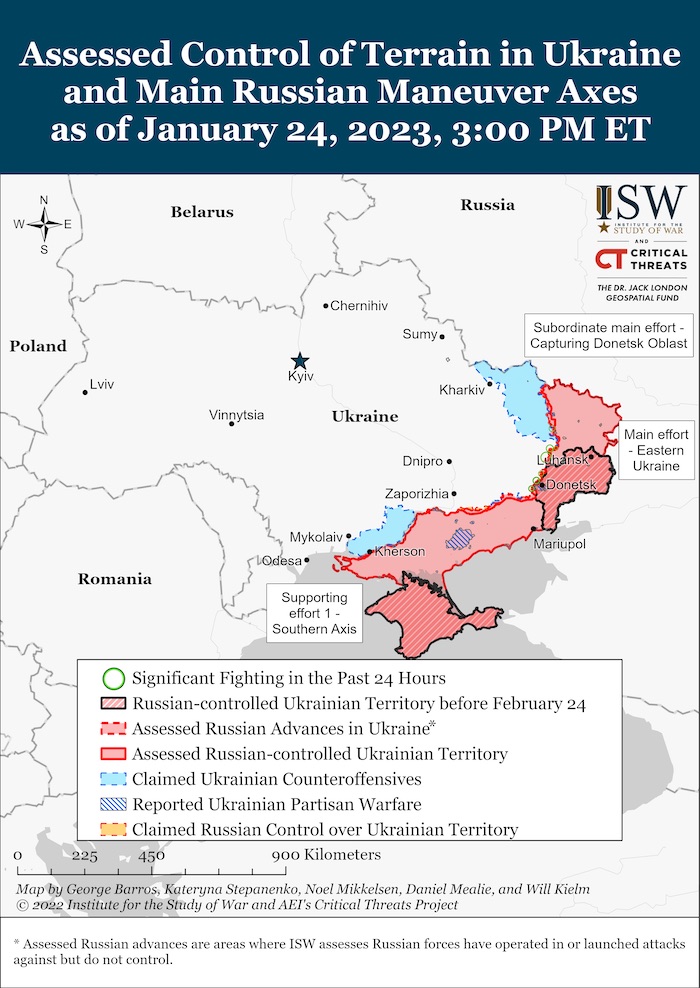
During the day, Russian forces launched 4 missiles and 26 air strikes and conducted more than 100 MLRS attacks.
The threat of Russian air and missile attacks remains high across Ukraine.
Despite numerous losses, Russia does not cease attempts to advance on Lyman, Bakhmut, Avdiivka and Novopavlivka axes. However, Russian forces stay on the defensive on Kupiansk, Zaporizhzhia, and Kherson axes.
Ukrainian Defence Forces repelled attacks in the vicinities of Bilohorivka (Luhansk oblast); Rozdolivka, Krasna Hora, Bakhmut, Novobakhmutivka, Krasnohorivka, Mariinka, and Charivne (Donetsk oblast).
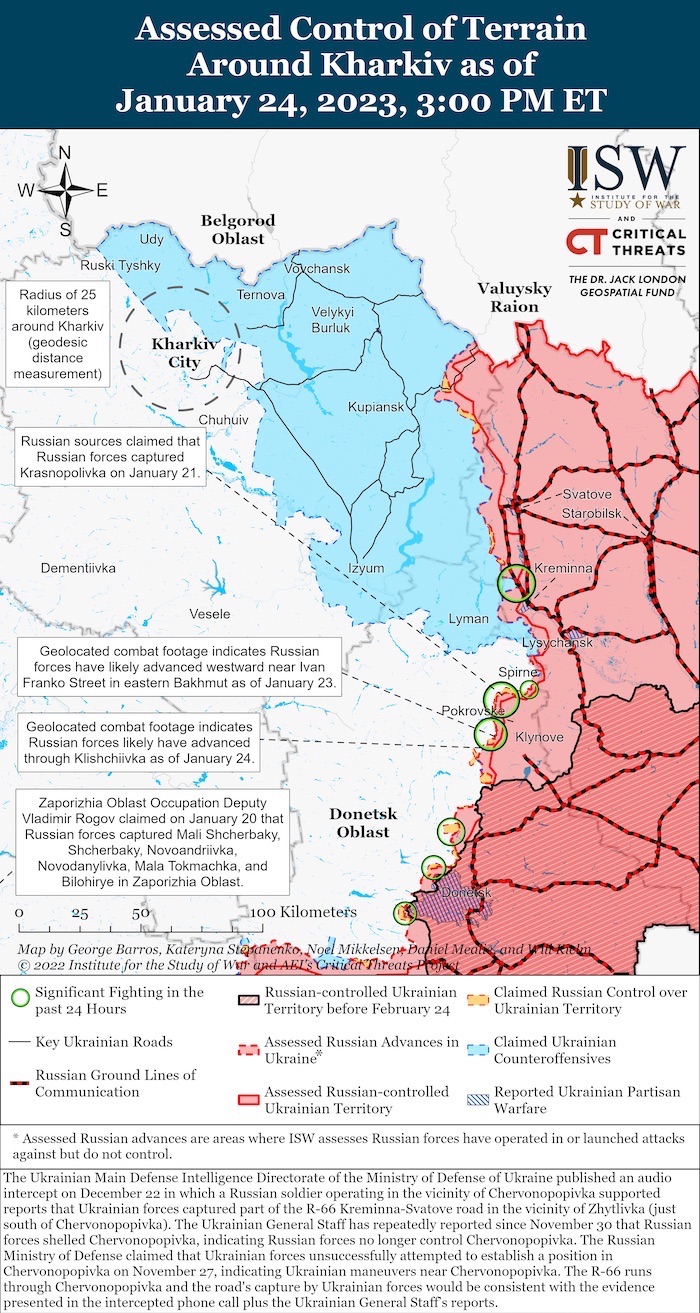
- Volyn, Polissya, Sivershchyna, and Slobozhanshchyna axes: no signs of enemy offensive groupings were detected. Russian forces shelled the vicinities of more than 40 settlements, including, Khrinivka and Karpovychi (Chernihiv oblast); Hlukhiv, Boyaro-Lezhachi, Atyns’ke, Solyanyki, and Pavlivka (Sumy oblast); as well as Hatyshche, Vovchansk, Vovchanski Khutory, Budarky, and Dvorichna (Kharkiv oblast).
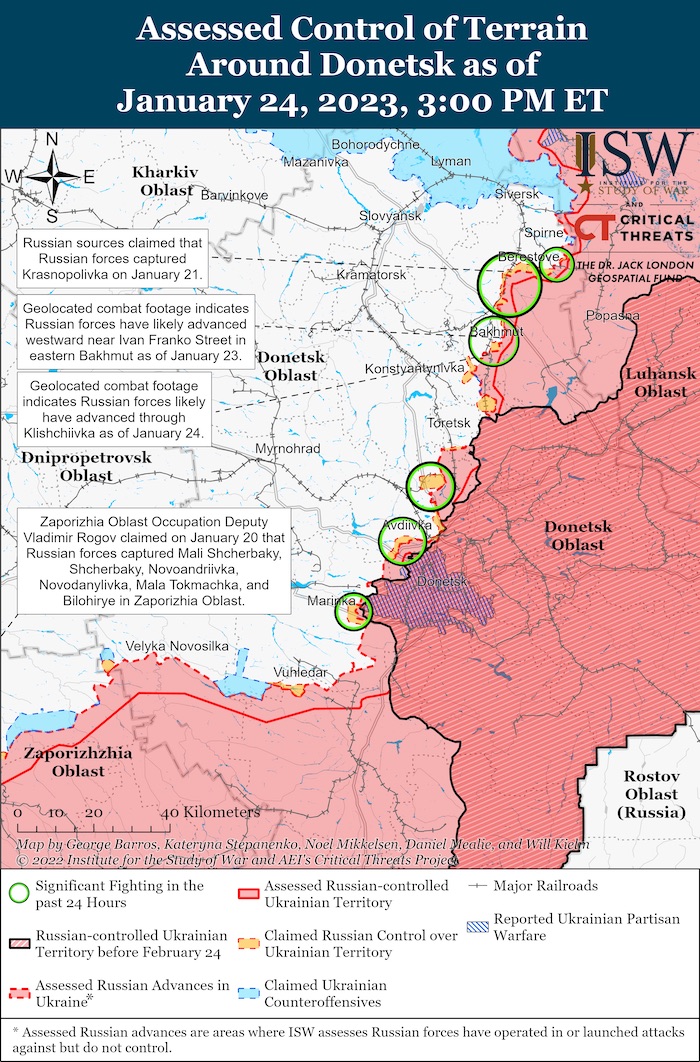
- Kupiansk axis: Russian forces shelled the vicinities of Vilshan, Synkivka, Ivanivka, Kotlyarivka, and Tabaivka (Kharkiv oblast); Novoselivske and Stelmakhivka (Luhansk oblast).
- Lyman axis: Makiyivka, Ploshanka, Chervopopivka, Nevske, Terny, and Yampolivka (Luhansk oblast) sustained damage as a result of Russian attacks.
- Bakhmut axis: more than 30 settlements were subject to Russian attacks, including, Verkhn’okam’yans’ke, Spirne, Bilohorivka, Krasnopolivka, Krasna Hora, Bakhmut, Ivanovske, Klishchiivka, Stupochki, Bila Hora, Kurdyumivka, Druzhba, Severnye, Zalizne, and New York (Donetsk oblast).
- Avdiivka axis: Novobakhmutivka, Berdychi, Orlivka, Avdiivka, Vodyane, Pervomais’ke, Nevels’ke, Krasnohorivka, Heorgiivka, Mariinka, Novomykhailivka, and Mykhailivka (Donetsk oblast) came under enemy fire.
- Novopavlivka axis: Novoukrayinka, Vuhledar, Prechistivka, Neskuchne, Bohoyavlenka, Velyka Novosilka, Zolota Niva, and Mykilske (Donetsk oblast) suffered enemy attacks.
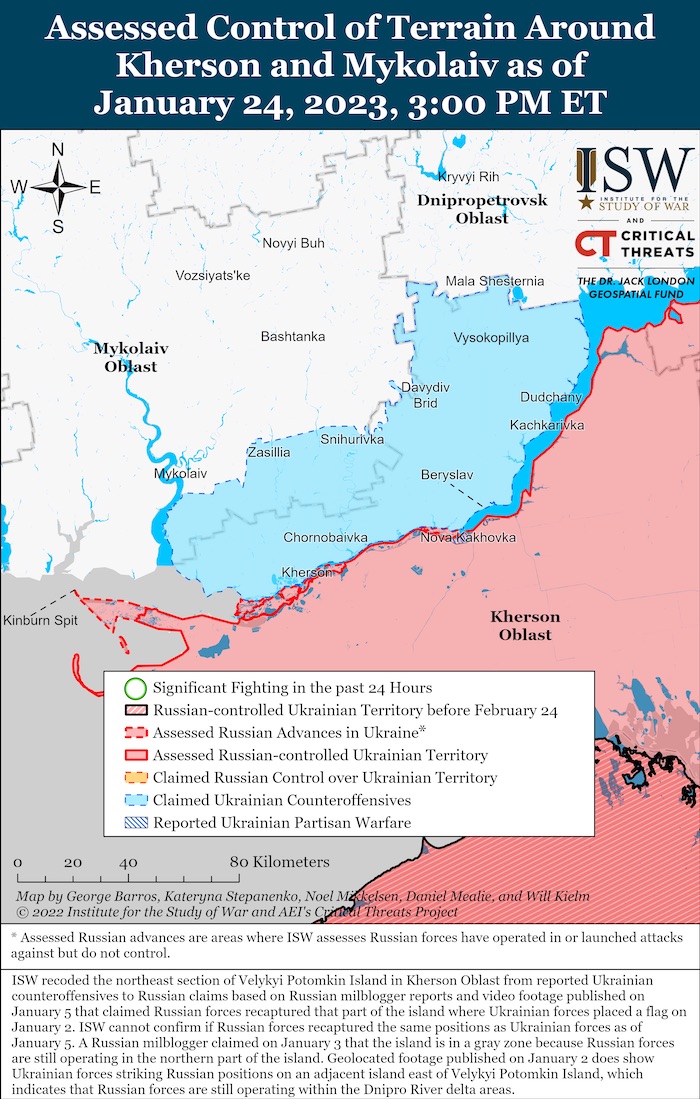
- Zaporizhzhia and Kherson axes: the vicinities of more than 40 settlements suffered tank and artillery attacks. Among the attacked settlements are Staroukrainka, Zaliznychne, Mala Tokmachka, and Novoandriyivka (Zaporizhzhia oblast); Zolota Balka, Mykhailivka, Novoberislav, Odradokamyanka, Ivanivka, and Veletens’ke (Kherson oblast), and the city of Kherson, where the invaders targeted a maternity hospital, a school and a polyclinic.
Russia is recruiting imprisoned Ukrainian citizens who were forcibly taken to Russian prisons. In particular, inmates of Krasnodar oblast (Russia) correction facilities are being actively recruited into the “Wagner Group” private military company. The majority of Ukrainian prisoners are not satisfied with their forced transfer to Russia and with the contemptuous attitude of Russian prisoners towards them. People who are serving sentences for serious criminal offences are most actively called to participate in the war against Ukraine.
The occupiers take out and transfer medical equipment from Kakhovka central city hospital (Kherson oblast) to the city of Henichesk (Kherson oblast).
[In the temporarily occupied territories of Ukrainian Crimea, the Russian Federation continues to covertly mobilize the local residents – citizens of Ukraine. In particular, Russian military commissariats in the city of Sevastopol have been tasked with replenishing Russia’s losses in the so-called “special military operation” by enrolling local civilians from the Black Sea Fleet units since January 20, 2023. All civilian employees are required to fill out forms with information about their military rank (in reserve) and the presence of a driver’s license.]
[Russian occupants continue to suffer significant losses in combat with Ukrainian Defense Forces. More than 450x wounded occupants are undergoing treatment in the city hospital of the occupied city of Dniprorudne (Zaporizhzhia oblast). Vasylivka district hospital (Zaporizhzhia oblast) is also packed with wounded Russian occupants beyond capacity.]
During the past 24 hours, Ukrainian Air Force delivered 8 air strikes on enemy concentration areas, and 3 air strikes against Russian anti-aircraft missile systems.
Meanwhile, Ukrainian defenders shot down 1x Russian SU-25 jet, 3x KA-52 attack helicopters, 3x “Orlan”-type UAVs, 1x “Merlin”-type UAV and 1x “Lancet”-type loitering munition.
Ukrainian missile and artillery units engaged 1 Russian command post and 9 concentrations of enemy troops and military equipment.
Military Updates
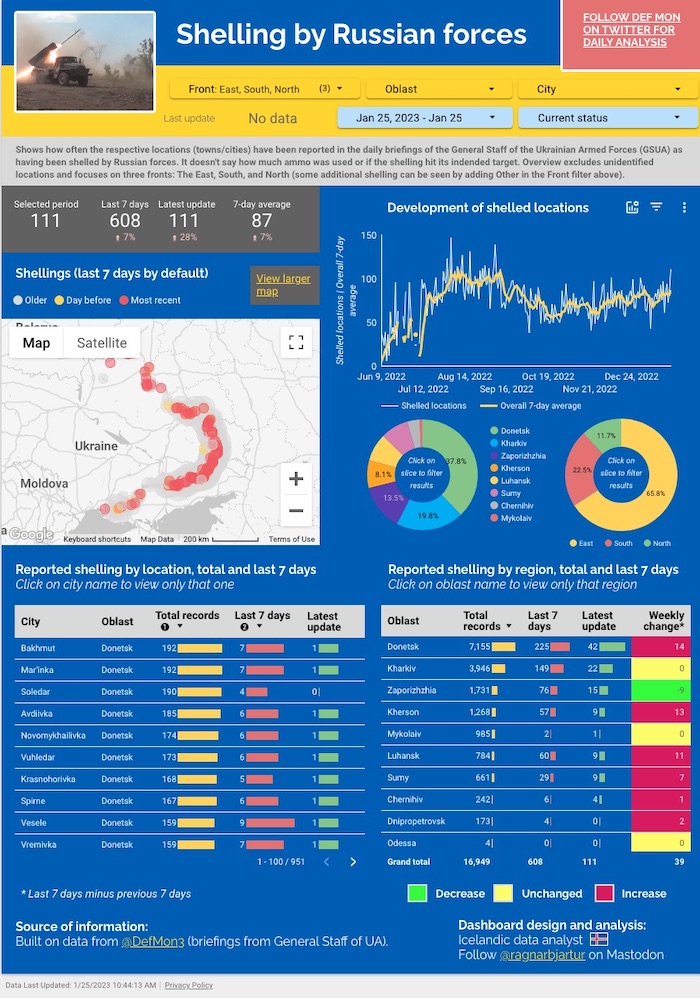
Russia keeps 28 Kalibr missiles ready for launch in the Black Sea, Ukrinform reports, citing Operational Command South. “The number of missile carriers in the naval formation of Russian forces fleet in the Black Sea has been increased. Among the 11 vessels, three are surface carriers of Kalibr missiles and one is a submarine, also carrying Kalibrs. The total salvo of the grouping is estimated as 28.»
The German newspaper Spiegel reports that according to its information, Germany has decided to send at least one company of the Leopard 2A6 main battle tanks to Ukraine, and grant permission to re-export Leopards to Ukraine.https://t.co/BuLCCjYSkP
— Euromaidan Press (@EuromaidanPress) January 24, 2023
According to British Defence Intelligence, (last 48 hours):
- As previously reported, Russia has worked to prepare a small number of T-14 Armata main battle tanks for the type’s first operational deployment in Ukraine.
- However, in recent months, deployed Russian forces were reluctant to accept the first tranche of T-14 allocated to them because the vehicles were in such poor condition.
- It is unclear exactly what aspects of the vehicles prompted this reaction, but within the last three years, Russian officials have publicly described problems with the T-14’s engine and thermal imaging systems. In 2021, Defence Minister Sergei Shoigu described the planned production run for 2022 as only an “experimental-industrial” batch. Therefore, it is unlikely that any deployed T-14 tanks will have met the usual standards for new equipment to be deemed operational.
- General Colonel Mikhail Teplinsky has likely been dismissed as one of Russia’s key operational commanders in Ukraine. Teplinsky was the officer on the ground in charge of Russia’s relatively successful withdrawal from west of the Dnipro in November 2022, and he has received praise in Russia as a capable and pragmatic commander.
- It remains unclear whether Teplinsky still retains his additional remit as head of the VDV, Russia’s airborne forces. There is a realistic possibility that debate over the tasks VDV has been given has contributed to his dismissal: VDV has often been employed in ground holding roles traditionally given to the mechanised infantry.
- Teplinsky’s dismissal is likely another symptom of continued divisions within the senior hierarchy of Russia’s operation as General Valery Gerasimov attempts to impose his personal authority on the campaign.
Losses of the Russian army
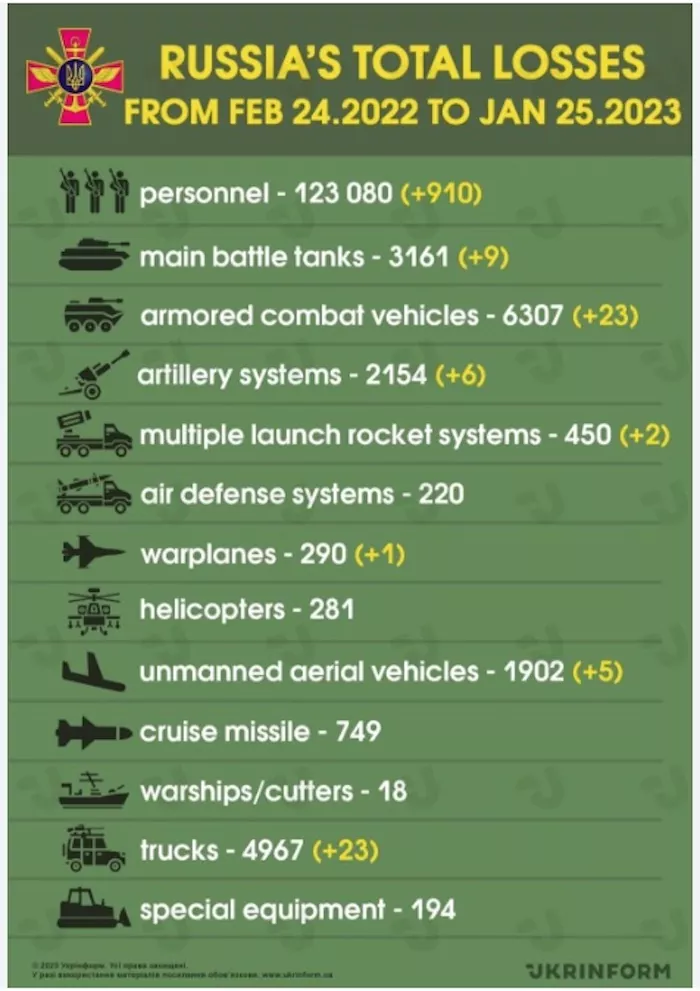
As of Tuesday 24 January, the approximate losses of weapons and military equipment of the Russian Armed Forces from the beginning of the invasion to the present day:
- Personnel – about 123080 (+910),
- Tanks – 3161 (+9),
- Armoured combat vehicles – 6307 (+23),
- Artillery systems – 2154 (+6),
- Multiple rocket launchers –MLRS - 450 (+2),
- Air defence means – 220 (+0),
- Aircraft - 290 (+1),
- Helicopters - 281 (+0),
- Automotive technology and fuel tanks – 4967 (+23),
- Vessels/boats - 18 (+0),
- UAV operational and tactical level – 1902 (+5),
- Special equipment – 194 (+0),
- Mobile SRBM system – 4 (+0),
- Cruise missiles – 749 (+0)
Imagery shows how a cemetery for Russian mercenaries is expanding, The New York Times reports. “A cemetery used by the notorious Russian mercenary group Wagner has grown rapidly in size over the past several months, according to interviews and an analysis by The New York Times of satellite imagery and video footage. The expanded burial ground is rare visual evidence that shows the toll the invasion of Ukraine is taking on Wagner, especially its rank-and-file soldiers.
The expansion coincides with a bloody offensive by Russian soldiers and mercenaries to gain ground in eastern Ukraine. The US government says that Wagner’s battlefield casualties are in the thousands and that 90 percent of them are inmates who were recruited to fight in exchange for being released from prison, assuming they survived.
A satellite image captured on Jan. 24 shows about 170 burial plots in an area of the cemetery known to hold Wagner fighters, a number that has increased to nearly seven times that seen on satellite imagery just two months ago.”
Humanitarian
#Ukraine civilians disappear without trace after #Russia invaders claim to have ‘humanely deported’ them from #Zaporizhzhia oblast #Melitopol #StandWithUkraine #RussiaWarCrimes #StopRussia https://t.co/LlIfpKPiyj pic.twitter.com/F6fNmrb59N
— Halya Coynash (@halyapuff) January 24, 2023
Electricity generation up in Ukraine, while deficit remains significant – Ukrenergo, Ukrinform reports, citing Ukrenergo. "Electricity consumption is at the level of Monday. Electricity generation increased slightly. The capacity deficit remains significant, the statement reads.
It is noted that consumption caps for the whole day have been established for all regional distribution companies. Each regional energy company in its respective region shall draw up schedules of planned hourly outages, which must ensure that consumption is within the approved cap. Exceeding the limits leads to risks of emergency situations in the power system. Therefore, emergency shutdowns are applied to prevent them. […]
As reported, Ukraine's energy system has already survived 12 enemy missile attacks and 14 UAV strikes. In addition, more than 10 GW of the main installed capacities is currently inaccessible to the Ukrainian energy system and under Russian forces' control. This is the Zaporizhzhia NPP, the largest in Ukraine and Europe Zaporizhzhia TPP, Luhansk TPP, Vuhlehirsk TPP, and Kakhovska HPP. In addition, the majority of wind and solar power plants are located in the temporarily occupied territories of the south.”
NPPs cover 55% of Ukraine’s power consumption – Energoatom, Ukrinform reports, citing Energoatom. "On January 24, 2022, eight power units of Ukrainian nuclear power plants located on the government-controlled territory are operating at maximum nominal capacity, covering nearly 55% of the country’s total electricity consumption. The largest volumes of electricity are generated by the South Ukrainian NPP," the statement reads.
At the same time, one of the units is still undergoing scheduled maintenance, carried out once every four years to ensure nuclear and radiation safety.”
OHCHR recorded 18,483 civilian casualties in Ukraine as of 23 January. 7,068 were killed (including 438 children) and 11,415 injured (including 838 children).
Millions of refugees from Ukraine have crossed borders into neighbouring countries, and many more have been forced to move inside the country. The escalation of conflict in Ukraine has caused civilian casualties and destruction of civilian infrastructure, forcing people to flee their homes seeking safety, protection and assistance the UNHCR reports. As of 17 January:
| Individual refugees from Ukraine recorded across Europe: | 7,976,980 |
| Bulgaria, Czech Republic, Hungary, Poland, Republic of Moldova, Romania, Slovakia | 2,444,766 |
| Other European countries | 2,660,490 |
| Russian Federation, Belarus | 2,871,724 |
| Refugees from Ukraine registered for Temporary Protection or similar national protection schemes in Europe: | 4,939,057 |
| Bulgaria, Czech Republic, Hungary, Poland, Republic of Moldova, Romania, Slovakia | 2,441,946 |
| Other European countries | 2,497,111 |
| Border crossings from Ukraine (since 24 February 2022): | 17,688,845 |
| Border crossings to Ukraine (since 28 February 2022): | 9,585,700 |
Environmental
Russia causes damage to Ukrainian infrastructure worth of US$138 billion, Ukrainska Pravda reports, citing KSE Institute's updated assessment. “Since November, the amount of damage has increased by US$2 billion. Firstly, this amount is due to the destruction of the housing stock, educational institutions, and cultural, sports and religious facilities.
Damage from the destruction of the housing stock is estimated at US$54 billion. In December, this amount increased by another US$1.5 billion. For more than ten months of the war, a total of 149,000 residential buildings have been damaged or destroyed, most of which were private houses (131,000).
The areas most affected by the war are the infrastructure, with losses of US$35.6 billion, as well as industry and businesses losses (US$13 billion). Infrastructure is also gradually being restored: by the beginning of December, out of more than 150 destroyed or damaged bridges or overpasses, traffic was restored on 72 facilities, and by the beginning of January, it was restored on 78 facilities.
Russia continues to cause damage to educational institutions in Ukraine. The amount of losses in this area increased by US$400 million and now is US$8.6 billion. As a result of combat actions, more than 3,000 educational institutions have already been damaged or destroyed, including 1,000 secondary education institutions, 865 pre-school institutions, and 505 higher education institutions.
Losses caused by the war to cultural, sports and religious institutions increased by another US$100 million, and in total are estimated at US$2.2 billion.
At least 64 large and medium-sized businesses, 84,000 units of agricultural machinery, 31 boarding schools, 44 social centres, almost 3,000 shops, 593 pharmacies, almost 195,000 private passenger cars, 14,000 public transport units, 330 hospitals, 595 administrative buildings of state and local government have been damaged, destroyed or occupied since the beginning of Russia’s full-scale invasion of Ukraine.”
Legal
Army food procurement scandal latest:
-MoD denies accusations,
-Anti-corruption organs will check contract
-deputy DeMin resigns
-MPs propose partially opening registers on military procurement to enable public control & transparency, despite martial lawhttps://t.co/Ts1cDLruxp— Euromaidan Press (@EuromaidanPress) January 24, 2023
Russian war in Ukraine: 14,578 children deported, Ukrinform reports, citing the Ombudsman's Office. “Some 14,578 children are believed to have been deported from Ukraine to Russia since the full-scale invasion.
In addition, according to the data of the "Children of War" government-run child search portal, as of January 24, 2023, a total of 343 children are considered missing, while 9,206 have been found.
As reported, according to information provided by juvenile prosecutors, 459 children were killed and more than 914 – injured across Ukraine as a result of Russian aggression.”
Russia wants to create over 20 penal colonies in occupied part of Ukraine, Ukrainska Pravda reports, citing Russian Government decree and Meduza. “The Russian invaders are planning to create 12 correctional facilities in occupied Donetsk Oblast, 7 in Luhansk Oblast, 3 in the annexed part of Kherson Oblast, and 2 (including a minimum security prison) in the annexed part of Zaporizhzhia Oblast.
The Russian Government also plans to create three medical correctional facilities and three correctional centres there.”
Support
Finnish president arrived in Kyiv https://t.co/43DL6oo6Mo
— Euromaidan Press (@EuromaidanPress) January 24, 2023
Type of warplanes to be provided by partners already determined, Ukrinform reports, citing Colonel Yuriy Ihnat, the spokesman for the Air Force Command. “It is already known what type of warplanes Ukraine will receive from its allies, as well as the terms of crew training. We asked to give Ukraine a multi-purpose aircraft even at the outset of Russian invasion. This is understandable because, without aviation, without reliable air cover, it is very difficult to conduct any combat operations at all, he emphasized. […]
Our war pilots went to the United States, funds were allocated for the training of our crews... That is, the aviation topic never left the agenda. The type of aircraft that will likely be provided to Ukraine and the corresponding terms of personnel training have already been determined, he said.
Ihnat explained that it is not only about the training of the crews, but also about that of aviation engineers. This is an extremely important component that cannot be ignored. That is why this process is not as simple as the preparation of infrastructure – here, too, the Ministry of Infrastructure will be involved in order to prepare the infrastructure of our military airfields to receive such equipment. All efforts are being made so that our dream of switching to this type of plane comes true as soon as possible, he said.[…]
It was also reported that the Netherlands would be ready to consider the transfer of F-16 fighter jets to Ukraine in case a corresponding request is filed.”
Italy confirms Samp-T missile-defense donation to Ukraine, Defense News reports. “Italy has confirmed it is ready to supply Ukraine with its Samp-T air defense system after weeks of doubt over Rome’s readiness to hand over the costly kit. Italy will team with France to send the system to Kyiv, which has issued an urgent appeal for air defense capabilities as Russia bombards Ukraine with missiles and mounts loitering munition attacks.”
The Biden administration is leaning toward sending a significant number of Abrams M1 tanks to Ukraine and an announcement of the deliveries could come this week, US officials said - WSJhttps://t.co/xVLcTWFWK1
— Euromaidan Press (@EuromaidanPress) January 24, 2023
The US decision to send M1 Abrams tanks to Ukraine breaks new ground, The New York Times reports. “Reversing its longstanding resistance, the Biden administration plans to send M1 Abrams tanks to Ukraine, US officials said on Tuesday, in what would be a major step in arming Kyiv in its efforts to seize back its territory from Russia. The White House is expected to announce a decision as early as Wednesday, said the officials, who spoke on the condition of anonymity because of the sensitivity of the discussions. One official said the number of Abrams tanks could be about 30. […]
Defense Secretary Lloyd J. Austin III has now come around to the view that committing to sending American tanks is necessary to spur Germany to follow with its coveted Leopard 2 tanks. Officials at the State Department and the White House argued that giving Germany the political cover it sought to send its own tanks outweighed the Defense Department reluctance, the officials said.
The movement toward sending the Abrams tanks, first reported by The Wall Street Journal, follows a testy confrontation last week during a NATO defense chiefs meeting over the refusal by Germany’s chancellor, Olaf Scholz, to send the Leopards, which many military experts believe could be a critical weapon in Ukrainian hands.”
US to give Ukraine advanced M1 tanks, The Washington Post reports. “The Biden administration has decided to provide M1 Abrams tanks to Ukraine, overriding previous concerns that the heavy battle tanks, the world’s most powerful, are too logistically burdensome for Kyiv’s forces, according to US officials.
The decision, due to be announced Wednesday, comes after a rare dispute last week among Western allies over the provision of tanks made in Germany, which has been reluctant to allow its Leopard 2 main battle tanks to be transferred to Ukraine unless the United States first provides Abrams.
The US vehicles, probably numbering at least 30, are unlikely to arrive by spring, when Russian forces are expected to begin a new offensive and Ukraine plans to launch its own counteroffensive to take back Russian-occupied territory. Instead, the Abramses are probably not for the near fight, one US official said, and are not likely to arrive for many months, if not years.”
German media reports government has approved sending Leopard 2 tanks to Ukraine, EuroNews reports. “The German government has given a greenlight to the shipment of "Leopard 2" tanks to Ukraine, according to reports in Der Spiegel.
The German online news website said the government is prepared to authorise the transfer of at least one company behind the "Leopard 2A6" model to the embattled country.
Berlin has been facing increasing international pressure over the past few days to approve the dispatch of the tanks to Ukraine. Olaf Scholz, German Chancellor, had the final say, and it is believed that the government will also approve licences for other allied countries to deploy the tanks to Ukraine.”
The Netherlands wants to buy 18 Leopard 2 tanks from Germany in favour of Ukraine, Ukrainska Pravda reports, citing Frankfurter Allgemeine Zeitung. “The Netherlands can buy 18 Leopard 2 tanks that were leased from Germany and transfer them to Ukraine within the framework of the tank coalition, which aims to send modern main battle tanks to this country, thus helping it to resist the Russian aggression. […]
On 24 January, it became known that Germany received a request from Poland concerning the re-export of Leopard 2 tanks to Ukraine. The German government stated that they wanted to review this application as quickly as possible. According to media reports, the decision may be announced on 25 January.”
Norway considers supplying Ukraine with up to 8 Leopard 2 tanks, Ukrainska Pravda reports, citing Dagens Næringsliv. “Norway is considering possibility supplying Ukraine with up to 8 Leopard 2 tanks, out of the 36 they have available.”
It is already known what type of aircraft the allies are likely to provide to Ukraine and what the terms of personnel training are - Ukraine's Air Force spox Ihnathttps://t.co/AB0WATHs2P
— Euromaidan Press (@EuromaidanPress) January 24, 2023
Ukraine expects to get 100 Leopard 2 tanks from 12 countries, once Germany approves: Senior Ukrainian official, ABC News reported on 23 Jan. “Twelve countries have agreed to supply Ukraine with around 100 Leopard 2 tanks if the German government gives its consent, according to a senior Ukrainian official who spoke exclusively to ABC News. Those agreements, the source said, were made at Friday's summit at Ramstein US Air Force Base in Germany when allied nations discussed military support for Ukraine.
Countries such as Poland and Finland have already indicated publicly that they are willing to provide a number of their Leopard 2 tanks to Ukraine. The Ukrainian official with knowledge of the matter said Spain, the Netherlands and Denmark were also willing to provide some of their tanks, however Germany's consent was still necessary for the coalition of countries to proceed on the matter.”
Pentagon says first Bradley IFVs to arrive in Ukraine in coming weeks – media, Ukrinform reports. “The first batch of US Bradley infantry fighting vehicles is expected to arrive in Ukraine in the "relatively near future", within weeks. In the last announced package of weapons, we focused on providing the Ukrainians with capabilities that they can use immediately to change the balance of forces on the battlefield," an anonymous high-ranking official of the US Department of Defense told the Voice of America on Monday. […]
As reported, in two large-scale packages of military aid, the United States announced the transfer of more than 100 Bradley infantry fighting vehicles to Ukraine. Currently, the Ukrainian military is undergoing several weeks of training on vehicles in Germany.”
Pentagon will increase artillery production sixfold for Ukraine, The New York Times reports. “The Pentagon is racing to boost its production of artillery shells by 500 percent within two years, pushing conventional ammunition production to levels not seen since the Korean War as it invests billions of dollars to make up for shortfalls caused by the war in Ukraine and to build up stockpiles for future conflicts. […]
Before Russia invaded Ukraine on Feb. 24, the US Army’s production of 14,400 unguided shells a month had been sufficient for the American military’s way of war. But the need to supply Kyiv’s armed forces prompted Pentagon leaders to triple production goals in September, and then double them again in January so that they could eventually make 90,000 or more shells a month.”
New Developments
During a #UNESCO session in Paris, Russian representatives attempted to introduce an amendment to exclude the inclusion of the historic center of #Odesa in the Main List of UNESCO World Heritage Sites from the agenda. It was rejected. https://t.co/2qENZSHiri https://t.co/Mx9vZIubFd
— Euromaidan Press (@EuromaidanPress) January 24, 2023
- PACE recognizes that Russia started war against Ukraine in 2014, Ukrinform “The Parliamentary Assembly of the Council of Europe (PACE) has endorsed a resolution, recognizing that the Russian Federation has waged a war of aggression against Ukraine since February 2014. The relevant resolution, entitled ‘Conflict-related sexual violence’, was endorsed during the PACE’s Winter Session 2023 in Strasbourg on Tuesday.”
- S. sees some Chinese companies helping Russia's Ukraine effort, Reuters reports. “The United States has determined that some Chinese companies are providing non-lethal assistance to Russia for use in the Ukraine war and officials are noting their concern to the Chinese government, a source familiar with the matter said on Tuesday. The source, speaking on condition of anonymity, said: What we're seeing is non-lethal military assistance and economic support that stops short of wholesale sanctions evasion."
- Zelenskyy: Russia prepares for new wave of aggression, Ukrainska Pravda "Russia is preparing for a new wave of aggression with the forces it is able to mobilise. The occupiers are already increasing pressure on the Bakhmut, Vuhledar and other fronts. And they want to increase pressure on a larger scale.[…] Zelenskyy noted that the free world must strengthen cooperation in order to prevent new Russian criminal acts as much as possible. The President stated that the first priority at the moment is the speed of implementation of all the agreements Ukraine made with its partners. In particular, there is a great need for modern tanks in Ukraine: it is not about five, or ten, or fifteen tanks. The need is greater."
- Zelenski sacks more than a dozen top officials amid allegations of corruption in Ukraine, News 360 “President Zelensky announced Tuesday the dismissal of more than a dozen governors, deputy ministers and even his deputy advisor, days after announcing that there would be changes at the top of the country following several scandals within the Ministry of Defense and the arrest of a deputy minister for allegedly accepting bribes.”
- Ukrainian lawmakers draw up defence transparency bill after graft claims, Reuters reports. “Ukraine's ruling party drew up a bill on Tuesday aiming to boost transparency in defence procurement after an army food contract became the subject of high-profile corruption allegations, according to parliament's website. President Volodymyr Zelenskyy's team is trying to set out a tough stance against graft after the Defence Ministry was accused by a media outlet of overspending on food. The ministry denied the allegations.”
- Russia's military reforms respond to NATO's expansion, Ukraine -chief of general staff, Reuters “The military reforms, announced mid-January, have been approved by Putin and can be adjusted to respond to threats to Russia's security, Gerasimov told the news website Argumenty i Fakty in remarks published late Monday. Today, such threats include the aspirations of the North Atlantic Alliance to expand to Finland and Sweden, as well as the use of Ukraine as a tool for waging a hybrid war against our country, said Gerasimov, who is also the chief of Russia's military general staff. Valery Gerasimov, in his first public comments since his Jan. 11 appointment to the role, admitted also to problems with the mobilisation of troops, after public criticism forced President Vladimir Putin to reprimandthe military.”
- Türkiye cancels trilateral Sweden-Finland meet after protest, Reuters “Türkiye has cancelled indefinitely a trilateral mechanism meeting with Sweden and Finland scheduled for February after a weekend protestin Stockholm that drew condemnation from Ankara, state broadcaster TRT reported on Tuesday.”
- Finland says time-out needed in talks with Türkiye over NATO bid, Reuters “Finland's foreign minister said on Tuesday that a pause of a few weeks was needed in Finland and Sweden's talks with Türkiye on their application to join the NATO military alliance. Türkiye's president said on Mondaythat Sweden should not expect his country's support after a protest near the Turkish Embassy in Stockholm at the weekend, which included the burning of a copy of the Koran.»
- Belarus leader says he has been asked to seal a non-aggression pact with Ukraine, Reuters “Belarusian leader Aliaksandr Lukashenka said on Tuesday that he had been asked to conclude a non-aggression pact with Ukraine, the Belta state news agency reported, citing comments that suggested he saw Kyiv as a potential threat. Lukashenka, a close ally of Russian President Vladimir Putin, disclosed the alleged offer to a meeting of government and law enforcement officials at which he also accused Ukraine - without evidence - of allowing its territory to be used by the West to train and arm militants who could destabilise the situation in Belarus.”
- Zelenskyy: We've never had any intention of attacking Belarus, Ukrainska Pravda “President Volodymyr Zelenskyy has said that Ukraine has never had any intention of attacking Belarus. He stated this in response to the claims of Aliaksandr Lukashenka, self-proclaimed President of Belarus, that Ukraine continues to train militants and extremists".
- Switzerland plans to allow re-export of arms to Ukraine, Ukrainska Pravda reports, citing European Pravda, with reference to the statement published on the Swiss Parliament website. “The Commission for the Security Police of the National Council of Switzerland (lower house of the Parliament) approved the initiative of the Members of Parliament, which will allow the re-export of Swiss armament from third countries to Ukraine. […] Meanwhile, the Commission stressed that the government must preserve its right to support the re-export ban if its cancellation goes against Switzerland’s main interests on the international arena. If the Commission achieves its goal, the changes to the law will come into force on 1 May and will be valid until the end of 2025.”
- Ukraine's Defence Intelligence: Putin is treated by best Western doctors, which is why he is still alive, Ukrainska Pravda reports, citing Delfi. “Major General Vadym Skibitskyi, Deputy Head of the Defence Intelligence of Ukraine, is convinced that the health of the aggressor's country president is being taken care of by the best Western doctors, which is why he is still alive.”
- Gerasimov complains about intensity of hostilities which Russia has never before experienced, Ukrainska Pravda reports, citing ru. “Valery Gerasimov, the Chief of the General Staff of the Russian Federation, has complained that the intensity of hostilities in the war in Ukraine has put the occupying Russian troops in conditions that they have never encountered before in the history of modern Russia.”
- Donor countries to hold financial Ramstein meeting for Ukraine this week – Ukraine's Prime Minister, Ukrainska Pravda “Prime Minister Denys Shmyhal announced the holding of a financial Ramstein this week. The G7 countries created a multi-donor coordination platform, the so-called financial Ramstein. It will work in three main directions: permanent short-and long-term support for Ukraine; international financing; and coordination of private sector reforms and development. We expect that the first meeting of the platform's executive Secretariat will be held this week. The EU and G7 countries, the IMF, the EIB, the EBRD, the OECD and other international financial organisations will cooperate in the format of the financial Ramstein, Shmyhal noted.”
- Ukraine's Commander-in-Chief inherits US$1 million and donates it to Ukrainian army, Ukrainska Pravda reports, citing The New York Times. “The Commander-in-Chief of the Armed Forces of Ukraine, General Valerii Zaluzhnyi, inherited US$1 million from a Ukrainian American in the United States. In turn, he donated all the money to the Ukrainian army.”
https://twitter.com/EuromaidanPress/status/1618027033560506368
Assessment
- On the war.
The Institute for the Study of War has made the following assessment as of January 24, 2023:
“Russian forces continued offensive operations around Bakhmut on January 24. The Ukrainian General Staff reported that Ukrainian forces repelled Russian assaults near Bakhmut itself; within 22km northeast of Bakhmut near Bilohorivka, Rozdolivka, Sil, and Krasna Hora; and 7km southwest of Bakhmut near Klishchiivka. Geolocated footage posted on January 23 likely indicates that Russian forces have advanced west of Pidhorodne (5km northeast of Bakhmut) and that they control the settlement. Geolocated footage posted on January 23 indicates that Russian forces have likely made marginal advances in the eastern outskirts of Bakhmut. The Donetsk People’s Republic (DNR) Territorial Defense reiterated claims that Russian forces captured Dvorichchia (12km north of Bakhmut) and Krasnopolivka (15km northeast of Bakhmut) as of January 23, although ISW has not observed visual confirmation to corroborate these claims. Russian milbloggers claimed that Wagner Group fighters are attacking in the direction of Vesele (20km northeast of Bakhmut), Mykolaivka (17km northeast of Bakhmut), and north of Blahodatne (12km northeast of Bakhmut). A Russian milblogger claimed that Russian forces entered the southeastern part of Paraskoviivka (9km north of Bakhmut), although ISW has not observed visual confirmation of this advance. Another Russian milblogger claimed that Wager Group fighters continued attempts to advance in the southern, northern, and eastern outskirts of Bakhmut. Geolocated footage published on January 23 shows Russian forces south of Bakhmut and west of Klishchiivka and likely indicates that Russian forces control the settlement. Russian milbloggers claimed that Russian forces are attempting to advance toward Ivanivske (6km west of Bakhmut) and conducted an assault near Predtechyne (15km southwest of Bakhmut) to cut a section of the T0504 Kostiantynivka-Chasiv Yar-Bakhmut highway.
Russian sources continue to falsely claim that Russian forces are cutting off Ukrainian ground lines of communication (GLOCs) into Bakhmut as of January 24. DNR Head Denis Pushilin claimed that Ukrainian forces only control one road into Bakhmut after the Russian capture of Klishchiivka gave Russian forces operational control over the majority of the GLOCs in the Bakhmut area. A Russian milblogger claimed that Russian forces are able to completely interdict Ukrainian forces on the M03 highway between Pidhorodne, Paraskoviivka, and Krasna Hora as of January 20 and on the T0504 highway between Ivanivske and Bakhmut as of January 22. The Russian milblogger claimed that the T0504 highway between Chasiv Yar and Bakhmut is Ukrainian forces’ last remaining GLOC into Bakhmut that Russian forces are not fully interdicting. Another Russian source had previously claimed that Russian forces could completely interdict all Ukrainian GLOCs into Bakhmut as of December 1, 2022. Russian sources are likely amplifying the claim that Russian forces can interdict the majority of Ukrainian GLOCs into Bakhmut to present recent tactical advances as operationally significant and to combat assessments that the Russian offensive to capture Bakhmut is likely culminating. ISW continues to assess that Russian forces have not cut the majority of Ukrainian GLOCs into Bakhmut. These GLOCs have been within the range of Russian tube artillery for months; recent Russian tactical gains around Soledar and Klishchiivka have not granted Russian forces new capability to interdict these GLOCs beyond what already possessed.
Russian forces continued offensive operations in the Avdiivka-Donetsk City area on January 24. The Ukrainian General Staff reported that Ukrainian forces repelled Russian assaults near Novobakhmutivka (14km northeast of Avdiivka) and within 32km southwest of Avdiivka near Krasnohorivka, Vodyane, and Marinka. Geolocated footage published on January 17 and 23 indicates that Russian forces have likely advanced into the outskirts of Vodyane (7km southwest of Avdiivka). A Russian milblogger claimed that the DNR "Somalia" Battalion occupied unspecified high ground near Vodyane and pushed Ukrainian forces out of the settlement. Another Russian milblogger claimed that Russian Special Forces and the DNR "Sparta" Battalion captured Vodyane and cleared the settlement, although ISW still cannot independently verify that Russian forces have captured the settlement. A Russian milblogger claimed that Russian forces also conducted an assault in the direction of Pervomaiske (12km southwest of Avdiivka). Ukrainian forces conducted a HIMARS strike against Russian railroad infrastructure in Ilovaisk (14km east of Donetsk City) on the night of January 23 to 24.
Russian sources widely claimed that Russian forces launched an offensive around Vuhledar (28km southwest of Donetsk City) on January 24. The claim was likely meant to generate positive narratives to distract from the lack of progress in Bakhmut. Russian milbloggers claimed that elements of the 155th Naval Infantry Brigade of the Pacific Fleet broke through Ukrainian defenses in the Vuhledar area and advanced north of Pavlivka (32km southwest of Avdiivka) and west of Mykilske (27km southwest of Avdiivka). Many Russian milbloggers amplified Vostok Battalion Commander Alexander Khodakovsky’s claim that the 155th Naval Infantry Brigade took part in the operations, but Khodakovsky edited his initial post, removing references to specific Russian units. DNR First Deputy Information Officer Danil Bezsonov claimed that the DNR "Kaskad" battalion also participated in offensive operations in the Vuhledar area. Russian milbloggers claimed that Russian forces are continuing offensive operations towards Vuhledar and also near Velyka Novosilka (55km southwest of Donetsk City). ISW has not observed any footage indicating that Russian forces have launched a localized offensive in the Vuhledar area as of January 25. Russian sources likely intend to repeat a similar ongoing effort in Zaporizhzhia Oblast, where Russian sources have circulated claims of localized Russian advances without any confirmation to distract from the fact that Russian forces have not made any operationally significant gains around Bakhmut. Whether Russian forces are conducting localized offensive operations near Vuhledar or Russian sources are exaggerating Russian activity on this sector of the front, the Russian effort is likely focused on supporting this information operation and does not portend a resumption of a Russian offensive in western Donetsk Oblast. The 155th Naval Infantry Brigade was previously badly degraded during offensive operations in the Vuhledar area in November 2022 and is unlikely to have the capacity to relaunch a new offensive on this sector of the front.
A coalition of NATO member states reportedly will send Ukraine modern main battle tanks. The Wall Street Journal reported on January 24 that US President Joe Biden is preparing to send "a significant number" of Abrams M1 tanks to Ukraine and that the White House may announce the delivery as soon as January 25. German newspaper Der Spiegel reported on January 24 that German Chancellor Olaf Scholz decided to deliver at least one tank company (14 tanks) of Leopard 2 main battle tanks to Ukraine in an unspecified time frame. Poland likely will send Ukraine Leopard 2 tanks following Germany’s decision. Polish Defense Minister Mariusz Błaszczak stated on January 24 that Poland formally requested Germany grant permission to transfer Poland’s Leopard 2 tanks to Ukraine, and German Foreign Minister Annalena Baerbock stated that Berlin would not interfere if Poland wanted to send its Leopard 2 tanks to Ukraine. British officials confirmed on January 16 that the United Kingdom would send Ukraine 14 Challenger 2 tanks to Ukraine. French President Emmanuel Macron stated he would not rule out the possibility of France sending Ukraine Leclerc tanks on January 22.
Western states’ provision of main battle tanks to Ukraine will help enable Ukraine to conduct mechanized warfare to defeat the Russian military and liberate Ukrainian territory. ISW previously assessed that the West has contributed to Ukraine’s inability to take advantage of having pinned Russian forces in Bakhmut by slow-rolling or withholding weapons systems and supplies essential for large-scale counteroffensive operations. Ukrainian Commander-in-Chief Valery Zaluzhny previously emphasized in December 2022 that Ukraine needs 300 main battle tanks (among other weapon systems) to enable Ukrainian counteroffensives.
Russian Chief of the General Staff Valery Gerasimov continued efforts to portray himself and the traditional Russian military command structure as the true defenders of Russia. Gerasimov reiterated on January 23 that Russian President Vladimir Putin approved Russian Defense Minister Sergey Shoigu’s plan to develop Russian forces’ ability to respond to "new threats to the military security" of Russia, and Gerasimov accused Ukraine and NATO states of aiming to threaten Russia. Gerasimov invoked the Russian General Staff’s historical role in guiding and protecting Russia through several military crises, including the Great Patriotic War (World War II). Gerasimov claimed that "modern Russia has never known such a level and intensity of hostilities" and heavily implied that the current war in Ukraine presents the greatest threat to Russia since the Great Patriotic War, therefore necessitating the leadership and protection of the Russian General Staff under Gerasimov’s leadership. Gerasimov’s framing of the war and the General Staff’s ongoing revitalization efforts within the historical context of the Great Patriotic War is part of the continued campaign to counter the growing power and influence of Wagner Group financier Yevgeny Prigozhin, Chechen Republic Head Ramzan Kadyrov, and their respective paramilitary structures, all of which threaten Gerasimov and the Russian General Staff as ISW has previously reported. It also continues Putin’s efforts to reframe the current struggle as an effort like the Great Patriotic War to justify protracted demands for sacrifice and mobilization by the Russian people.
Russian outlet RBK claimed on January 23 that Russian Defense Minister Sergei Shoigu appointed Colonel General Sergey Kuzovlev as the Southern Military District (SMD) commander and Lieutenant General Yevgeny Nikiforov as the Western Military District (WMD) commander. RBK claimed that Nikiforov replaced Kuzovlev as WMD commander after Kuzovlev held the position from December 13, 2022, to January 23, 2023. The United Kingdom Ministry of Defense (UK MoD) claimed that the Russian Ministry of Defense (MoD) appointed Kuzovlev WMD Commander in late October of 2022. RBK claimed that the Russian MoD had appointed Lieutenant General Roman Berdnikov as WMD commander in October of 2022, however. The Ukrainian Main Military Intelligence Directorate (GUR) reported on December 26, 2022, that Nikiforov left his position as Chief of Staff of the Eastern Military District (EMD) to replace Kuzovlev as a part of the internal power struggles between Wagner Financier Yevgeny Prigozhin, Shoigu, and Gerasimov. Nikiforov previously commanded Wagner Group fighters in Ukraine as commander of the 58th Combined Arms Army in 2014 and may have connections to Prigozhin. The conflicting reporting on the WMD and SMD command suggests that military district command dynamics remain opaque, indicating that the Russian military is struggling to institute sound command structures and maintain traditional command.
Key Takeaways
- A coalition of NATO member states reportedly will send Ukraine modern main battle tanks.
- Russian Chief of the General Staff Valery Gerasimov continued efforts to portray himself and the traditional Russian military command structure as the true defenders of Russia.
- Russian outlet RBK claimed on January 23 that Russian Defense Minister Sergei Shoigu appointed Colonel General Sergey Kuzovlev as the Southern Military District (SMD) commander and Lieutenant General Yevgeny Nikiforov as the Western Military District (WMD) commander.
- Russian forces continued limited counterattacks along the Svatove-Kreminna line and Ukrainian forces reportedly continued counteroffensive operations near Kreminna.
- Russian forces continued to conduct ground attacks in the Bakhmut and Avdiivka-Donetsk City area. Russian forces made marginal territorial gains near Bakhmut.
- Russian sources claimed, likely to distract from the lack of progress in Bakhmut, that Russian forces launched an offensive around Vuhledar.
- Russian forces likely continued to conduct limited and localized ground attacks in Zaporizhzhia Oblast but likely did not make territorial gains, further undermining Zaporizhzhia Oblast occupation official Vladimir Rogov’s prior territorial claims.
- Ukrainian special forces conducted a raid across the Dnipro River in Kherson Oblast on January 23-24.
- Russian authorities are likely continuing efforts to mobilize ethnic minorities to fight in Ukraine.
- Russia’s defense industrial base (DIB) is reportedly increasing the production of drones and loitering munitions.
Ukrainian partisans targeted a member of the Zaporizhzhia occupation administration.
Western allies urge Ukraine to shift from brutal eastern battles to focus on a southern offensive, CNN reports. “US and Western officials are urging Ukraine to shift its focus from the brutal, months-long fight in the eastern city of Bakhmut and prioritize instead a potential offensive in the south, using a different style of fighting that takes advantage of the billions of dollars in new military hardware recently committed by Western allies, US and Ukrainian officials tell CNN.
For nearly six months, Ukrainian forces have been going toe-to-toe with the Russians over roughly 36 miles of territory in Bakhmut, which lies between the separatist-held cities of Donetsk and Luhansk. Heavy shelling has left the city almost completely destroyed.
It is a brutal and grinding fight, a senior Western intelligence official said last week, with each side exchanging anywhere from 100-400 meters of land per day and exchanging several thousands of artillery rounds almost daily. [Bakhmut] is less attractive militarily, in terms of any sort of infrastructure, than it might have been if it had not been this destroyed.”
Now, ahead of what is widely expected to be a brutal spring of fighting, there is a tactical opening, US and Western officials say. In recent weeks they have begun suggesting that Ukrainian forces cut their losses in Bakhmut, which they argue has little strategic significance for Ukraine, and focus instead on planning an offensive in the south.”
Ukraine's Defence Intelligence shares expectations from February and March, explains changes in Russia's tactics, Ukrainska Pravda reports, citing Ukrinform’s interview with Vadym Skibitskyi, deputy head of the Ukrainian Defence Intelligence (DIU). "There will be active military operations in the Donetsk and Luhansk fronts. Valery Gerasimov (Chief of Russia's General Staff – ed.) did not complete the task that was set for him. The first is the complete occupation of the Donetsk and Luhansk oblasts. So, in February-March, there will be active military operations, and it is in the Luhansk and Donetsk oblasts (because Vladimir Putin ordered to "take Donbas" until March – ed.)
We are seeing the transfer of the 2nd Mechanised Division of the 1st Tank Army from Belarus. We do not rule out that they may again try to enter our territory across the border, this is the Kupiansk front, and it is possible to resume offensive operations in order to return the territories previously captured by Russian forces in the Luhansk region under control.
Skibitskyi noted that [DIU] sees "how they are now moving, where their (Russian) airborne units are being regrouped," and called it the "handwriting" of Valery Gerasimov, who replaced Sergei Surovikin as commander of the joint group of troops in Ukraine. […] Why? Because at the beginning of the full-scale aggression, we clearly knew that in all directions, in the second echelon, in fact, there were paratroopers in the strategic reserve, and in the offensive on Kyiv, they generally performed the main task. We expect that even now there will be a more active use of airborne troops.
Apparently, it was against this background that misunderstandings arose between Gerasimov and Commander of the Airborne Forces (during a meeting in the Russian General Staff, Mikhail Teplinsky told Gerasimov to go f*** himself and was dismissed – ed.).
First of all, due to the fact that under Gerasimov's command, almost half of the Russian airborne troops were knocked out in the first half of the Great War in Ukraine. And these are elite troops – the 76th Division, the 106th, the 98th… by the way, the latter was transferred from the Kherson front to other, more important ones, according to their estimates.
Skibitskyi also noted that the Russians were changing tactics, because they are not just learning, they have now begun to assess our power more realistically. […] The more we fight, the more they draw conclusions. They are now building a clearer [command and control] system along the entire front line, and we can clearly see this. They are changing the tactics of using their units.
If a year ago they were BTG, battalion tactical groups, now they have returned to the classic scheme of forces' management: a brigade, a regiment, a battalion. They began to create assault detachments numbering 140-160 people. Such detachments include mechanised units, tanks, artillery, mortars, and anti-tank weapons – to break through in certain areas precisely because of assault operations.
And there's also the Wagner Group tactic, which was used first in Bakhmut, then in Soledar. They are trying to conduct assault operations by delivering powerful artillery strikes in order to completely destroy our defensive positions. And wave after wave, they go on, despite the colossal human losses that they are suffering.
The deputy head of the [DIU] noted that the Russian invaders are also making certain changes in the use of cruise missiles: they choose other launch lines, other aviation flight routes, and try to "bypass" the Ukrainian air defence system. The longer the fighting lasts, the more experience Russian forces gains. And the threat is that their current mobilised people are already different from those who came to our territory in October, Skibitskyi said.”
Wagner Group tactics in Ukraine: Defence Intelligence report revealed, Ukrainska Pravda reports, citing CNN. “CNN journalists have received Ukraine’s Defence Intelligence data on the combat tactics of the Wagner Group private military company in Ukraine, according to which their effectiveness around Bakhmut is confirmed and the difficulty of confronting Russian militants is indicated.
The Ukrainian report dated December 2022 concludes that Wagner represents a unique threat at close quarters, even while suffering extraordinary casualties. The deaths of thousands of Wagner soldiers do not matter to Russian society, the report asserts, while at the same time indicating that Wagner Group fighters have become the disposable infantry of the Russian offensive in eastern Ukraine.
Assault groups do not withdraw without a command… Unauthorised withdrawal of a team or without being wounded is punishable by execution on the spot, stated in a Defence Intelligence document. Phone intercepts also indicate a merciless attitude on the battlefield. In one, a soldier is heard talking about another who tried to surrender to the Ukrainians. "The Wagnerians caught him and cut his f**king balls off," the soldier says.
It is noted that the wounded Wagner fighters are often left on the battlefield for hours. Assault infantry is not allowed to carry the wounded off the battlefield on their own, as their main task is to continue the assault until the goal is achieved. If the assault fails, retreat is also allowed only at night, states Ukraine’s Intelligence.
Despite a brutal indifference to casualties, demonstrated by Prigozhin himself, the Ukrainian analysis says that Wagner’s tactics are the only ones that are effective for the poorly trained mobilised troops that make up the majority of Russian ground forces. It is assumed that the Russian army may even be adapting its tactics to become more like Wagner. Instead of the classic battalion tactical groups of the Russian Armed Forces, assault units are proposed," says Ukraine’s Defence Intelligence. That would be a significant change from the Russians’ traditional reliance on big mechanised units.
The Ukrainian report says that Wagner deploys its forces in mobile groups of about a dozen or fewer, using rocket-propelled grenades (RPGs) and exploiting real-time drone intelligence, which the report describes as the "key element." […]
Convicts, tens of thousands of whom Wagner has recruited, frequently form the first wave of an attack and take the heaviest casualties, with as many as 80% of them being killed, according to Ukrainian officials. More experienced fighters, with thermal imagery and night-vision equipment, should follow them.
If Wagner forces succeed in taking a position, artillery support allows them to dig trenches and consolidate their gains, but those trenches are very vulnerable to attack in open land. However, according to Ukrainian intercepts, coordination between Wagner and the Russian military is often lacking. It is also reported that until the Russian Ministry of Defence achieves the desired result in the war, Prigozhin will be on his toes and demand more resources for Wagner.
The group also appears to be able to gain weapons by other means. US officials said last week that Wagner had sourced arms from North Korea. Last month, North Korea delivered infantry rockets and missiles into Russia for use by Wagner, National Security Council spokesman John Kirby said.”
- Consequences and what to do?
Only 6% of foreign companies left Russian Federation, 40% are not even considering it, Ukrainska Pravda reports, citing the Kyiv School of Economics (KSE) Institute. “As of 23 January, 177 foreign companies (6% of the total number of foreign companies in Russia) completely withdrew from the Russian market. Another 1,156 businesses (38%) have closed operations and are exiting the market now.
However, 16% of companies with foreign capital (489 businesses) have reduced current operations, suspended new investments and are still waiting. Another 1,203 (40%) foreign businesses operate in Russia without any restrictions.
KSE analysts estimated that foreign companies that left the Russian Federation for good employed 307,300 people (more than 22% of the staff of international companies represented in Russia).
Their annual income was US$42 billion, the capital of the companies was estimated at US$34.4 billion, and the value of assets reached US$37 billion. In 2021, they paid US$3.3 billion in taxes , i.e. 13.4% of the total amount of taxes paid by foreign businesses to Russian budgets on all levels.”
Hans Petter Midttun: The impending decision to provide Ukraine with Leopard 2 and Abrams main battle tanks are most welcome. Modern Western tanks will give the Ukrainian Armed Forces a crucially important technological edge on the battlefield. They are essential for its ability to manoeuvre and conduct combined arms operations. While Ukraine will have fewer tanks than Russia, it will have tanks with far better armour, weaponry and control systems than Russia. It makes a tremendous difference on the battlefield.
The speculations on a possible future delivery of F-16 are also extremely encouraging. If – or rather when that happens – this will mark yet another extremely encouraging turn of events.
The development is very much in line with my article “Why Ukraine will win in 2023”. “When I am optimistic for 2023, it’s because of the many processes that have started and that can no longer be reversed. Russia is seen for what it is. All hope for reset and business as normal has been quashed by its crime against humanity. Fear is giving way to resolve. The immature is maturing. Vulnerabilities are being closed. Production lines are being set up. The irresponsible are slowly turning responsible for the lack of other alternatives. The ones absent a moral compass are slowly finding their bearings because Russia's atrocities leave them no choice. Consequently, previous “nays” are inevitably being turned into “ayes”.”
That said, I will remain frustrated and impatient.
The decisions both made and yet to be made illustrates flawed strategic thinking and decision-making process. Timely decisions are crucial to the progress of all crises, conflicts, and wars. Effective crisis management requires not only great situational awareness but also the ability to act in a timely manner.
Timely execution of crisis management can stop a crisis from turning into a full-scale war, and reduce the costs of failing to avert the war.
So far, the West has failed more often than it has succeeded.
These are some of the facts supporting the assessment:
- During the Cold War, NATO responded resolutely to every provocation from the USSR. It never failed to demonstrate the will and ability to defend the member states. In the decades that followed, it has failed to respond to the many Russian transgressions of international law, including its hybrid war against Europa and the USA.
- When the war started in 2014, the West failed to act resolutely and decisively. The NATO member states decided – or rather aimed to - increase the defence budget's share of gross domestic product to 2% within 10 years. They were unable to fully commit to a NATO target they were supposed to have achieved eight years earlier even at a time of crisis. Eight years later, only 10 out of 30 countries have achieved the target.
- Despite Russia’s many transgressions of international law and provocations, the EU and the NATO member states did not escalate the sanctions when Russia refused to comply with international law. The member states did not strengthen their defence budgets; did not start rebuilding their command and defence structure; did not close existing critical vulnerabilities in defence and society; did not fill the empty stockpiles or increase their requirements for “Days of Supplies” available. It did not address the capability gap within its defence industries, NATO did not act on the Russian hybrid war against its member states and failed to exercise military diplomacy. The West failed to deter Russia from turning a low-intensity war into a full-scale war. Having made many of the required decisions after 24 February 2022, it is fair to say that they were too little, too late.
- When intelligence started warning of the full-scale invasion in the autumn of 2021, the West found itself unable to deliver the support Ukraine desperately needed on time. It only started delivering arms weeks before the Russian assault. While Javelins were the first lethal aid to be delivered in the spring of 2018, it was first delivered en mass along with Stinger in February, followed by Starstreak in March, M777 Howitzers in April, Brimstone and Harpoons in May, HIMARS and M270s in June, HARM in July, IRIS-T in October, NASAMS in November and lately, a pledge for Patriot in December. A number of the new pledges – including the delivery of air defence and main battle tanks – will first take place in 1-2 years.
A timely decision ensures the delivery of the tools needed in time to deter attacks – or failing to do that – avert new offensive, protect civilians, and critical infrastructure and allow Ukraine to defeat Russian forces at minimum costs. The West has failed to achieve any of these objectives.
Its support is no less crucial and at the end of the day, Western support will help defeat Russian forces in Ukraine. But at a much higher cost than needed if strategic decision-making processes had been attuned to Russia’s increasingly aggressive foreign policy over the last 15 years.
I rejoice for both the decisions made and yet to be made; while staying frustrated over a flawed decision-making process.
The full-scale invasion started 11 months and 1 day ago. While consensus building is crucial it is unacceptable that wartime decision-making processes take close to a year.
It is crucial to see the difference between doing something and doing what is needed. The US deployed 1900 Abrams to achieve a decisive victory against Iraq in 1991. Ukraine has asked for 300 western-made tanks. Presently, most analysts expect that it might receive around 100. The actual number will probably be disclosed in the upcoming days. Due to a faulty process, however, they might not arrive in time to deter the next Russian offensive. Ukraine needs time to train its personnel on all new systems, establish new units and set up an effective logistic organisation.
I fear NATO will continue to deter aggressions if it remains incapable of establishing more effective processes.
The strategy employed by Russia – the hybrid war – is bound to be adapted and employed by other opponents of the West. The parallel and synchronised use of both military and non-military means make it extremely difficult to detect and respond to Hybrid War. The holistic and comprehensive approach is possible because Russian military-strategic culture (unlike the West) reaches deeply into other security services and other government ministries, facilitating unity in its execution of what in essence is a total war.
While the EU has acknowledged being exposed to a Russian hybrid war (years after it started), NATO has yet not (publicly) reached the same conclusion.

